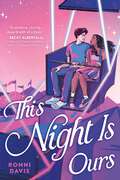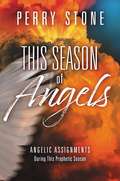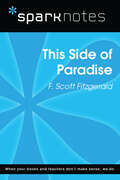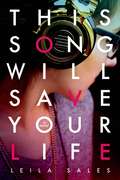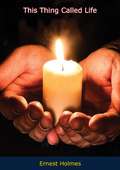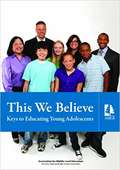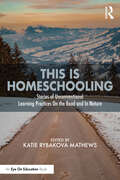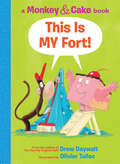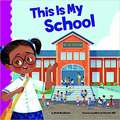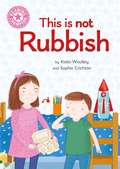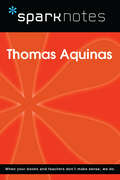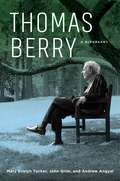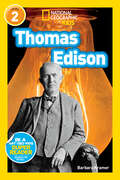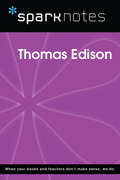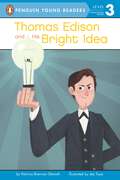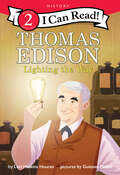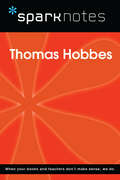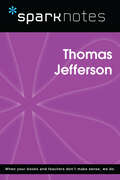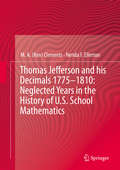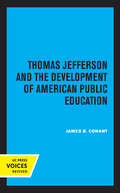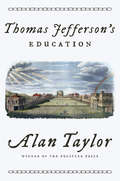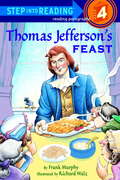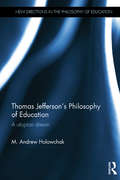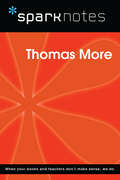- Table View
- List View
This Night Is Ours
by Ronni Davis&“Ronni Davis perfectly captures the terrifying joy of shaking off others&’ expectations and coloring in your own future—a sensitive, stirring, deep breath of a book.&” —Becky Albertalli, #1 New York Times bestselling authorFor one teen girl, the summer before college brings uncertainty about the future and a budding romance—perfect for fans of Nicola Yoon! It&’s the longest day of the year, and eighteen-year-old Brandy Bailey has just received the worst news of her life: She&’s been accepted to a top nursing school, making her mother overwhelmingly proud. The thing is, Brandy wants to be an artist. She knows all the risks of chasing her dream. She&’s heard them from her mother time and time again. Plus, Brandy&’s annoying classmate from high school, the annoyingly handsome Ben Nolan, is catching his far-fetched dream of being an actor. Why does he get to be fearless while she has to be practical? Ben is the last thing Brandy wants on her mind, so of course today is the day he decides to glue himself to her hip. Now his perfect face is right there in the cacophony crashing through her head. Swirling in too many directions, Brandy&’s emotions clash with the flashing lights at the town&’s summer carnival. Can she have one extraordinary night before everything changes? Ronni Davis spins a whirlwind summer romance full of cotton candy, funnel cake, and the sweetness of first love. Don't miss:When the Stars Lead to You
This School Year Will Be the BEST!
by Kay WintersOn the first day of school, new classmates are asked to share what they would most like to happen in the upcoming year. Some kids' hopes are familiar while others are off-the-wall. Whether it's looking good on picture day or skateboarding at school, everyone's wishes are shown in humorously exaggerated illustrations. As the first day draws to a close, there can be no doubt—this school year will definitely be the best!
This Season of Angels: Angelic Assignments During This Prophetic Season
by Perry StoneRenowned Bible teacher and prophecy expert, Perry Stone, reveals the significance of angels and their connection to major prophetic seasons.Incorporating deep truths from Scripture, and even personal supernatural experiences from his own life, THIS SEASON OF ANGELS peels away the veil of mystery from the subject of angels to reveal their divine missions. Perry also devotes a chapter to answering twenty controversial questions about angels others may be afraid to tackle. THIS SEASON OF ANGELS will leave you feeling refreshed, more informed, and even more protected by God.
This Side of Paradise (SparkNotes Literature Guide Series)
by SparkNotesThis Side of Paradise (SparkNotes Literature Guide) by F. Scott Fitzgerald Making the reading experience fun! Created by Harvard students for students everywhere, SparkNotes is a new breed of study guide: smarter, better, faster. Geared to what today's students need to know, SparkNotes provides: *Chapter-by-chapter analysis *Explanations of key themes, motifs, and symbols *A review quiz and essay topicsLively and accessible, these guides are perfect for late-night studying and writing papers
This Song Will Save Your Life
by Leila SalesMaking friends has never been Elise Dembowski's strong suit. All throughout her life, she's been the butt of every joke and the outsider in every conversation. When a final attempt at popularity fails, Elise nearly gives up. Then she stumbles upon a warehouse party where she meets Vicky, a girl in a band who accepts her; Char, a cute, yet mysterious disc jockey; Pippa, a carefree spirit from England; and most importantly, a love for DJing. Told in a refreshingly genuine and laugh-out-loud funny voice, This Song Will Save Your Life is an exuberant novel about identity, friendship, and the power of music to bring people together.
This Thing Called Life: Russian Version
by Ernest HolmesThe great contribution of Ernest Holmes to modern thought is the specific form of meditation and prayer by which man can control outward conditions of his life instead of permitting conditions to control him. Based soundly and thoughtfully upon the teachings of Jesus and other great spiritual leaders and philosophers, THIS THING CALLED LIFE is an outline of the practice of Faith by which problems of every kind may be solved by every man and woman, directly, simply and effectively.Recognised as one of the foremost teachers of religious science and philosophy since William James, in this book Mr. Holmes courageously declares that for centuries man has been putting the cart before the horse, that he is not helpless in the face of poverty, disease, evil and unhappiness, but that by this clear and simple system of thought and faith he can dominate them and introduce into his experience their exact opposites—abundance, health, good and happiness. If man will try and learn how to think, writes Mr. Holmes, he can dominate his entire life and everything in and around it.
This We Believe: Keys to Educating Young Adolescents
by National Middle School AssociationThe academic growth and personal development experienced during these important years significantly impact their futures. In the middle grades, the stage will be set for success in high school and beyond, or for disengagement and the likelihood of becoming a high school dropout.
This is Homeschooling: Stories of Unconventional Learning Practices On the Road and In Nature
by Katie Rybakova MathewsThe number of homeschooling families has grown in recent years, along with the number of methods for learning at home. In this timely book, you’ll meet diverse families that are engaging in the day-to-day work of a variety of approaches, including self-directed learning, unschooling, nature-based education, farmschooling, wildschooling, and worldschooling. Chapters and interludes are written by scholars and families engaged in this work, who show how their approaches take a balanced, slower-paced, and nature-minded approach to learning, nourishing the child’s heart and brain. They also address common critiques of homeschooling and show how it is something that can be normalized and encouraged as a positive educational tool, helping families bond and live life to the fullest. Each chapter includes practical applications you can use right away in your own journey. Simultaneously inspirational and practical, this book will help guide and motivate those who are either considering or already homeschooling to see the possibilities of what learning and education can truly be.
This is MY Fort! (Monkey and Cake)
by Drew DaywaltMeet Monkey and Cake.They are silly and they are curious.Sometimes they agree. Sometimes they do not.But they are always best friends. Monkey and Cake love building forts! When Cake decides to build his own fort, Monkey feels left out. Monkey builds his own fort that's even bigger than Cake's fort. But before long, they both discover that being alone in a fort is no fun!Drew Daywalt, author of the New York Times bestselling Crayon series, is one of the most influential voices in children's literature today. Brought to life by Olivier Tallec's expressive illustrations, Monkey and Cake combines the relatable humor of Elephant and Piggie and the wise friendship of Frog and Toad, inviting readers to laugh along and let their imaginations soar.
This is My School (School Rules)
by Mark WeaklandHow do I find my way around school? This Is My School gives young readers the grand tour through all the rooms and special areas that make up an elementary-school building. Featuring playful illustrations that embrace diversity, and led by a 1st-person student narrator, the tour takes kids to the front office, the library, the gym, the nurse’s office, and other rooms.
This is not Rubbish: Independent Reading Non-Fiction Pink 1a (Reading Champion #515)
by Katie WoolleyThis book is part of Reading Champion, a series carefully linked to book bands to encourage independent reading skills, developed with UCL Institute of Education (IOE)This is not Rubbish is a non-fiction text exploring how different objects may be reused and recycled. The repeated sentence structure offers readers the opportunity for a very first independent reading experience with the support of the illustrations.Reading Champion offers independent reading books for children to practise and reinforce their developing reading skills.This non-fiction text is accompanied by engaging artwork and a reading activity. Each book has been carefully graded so that it can be matched to a child's reading ability, encouraging reading for pleasure.
Thomas Aquinas (SparkNotes Philosophy Guide)
by SparkNotesThomas Aquinas (SparkNotes Philosophy Guide) Making the reading experience fun! SparkNotes Philosophy Guides are one-stop guides to the great works of philosophy–masterpieces that stand at the foundations of Western thought. Inside each Philosophy Guide you&’ll find insightful overviews of great philosophical works of the Western world.
Thomas Berry: A Biography (G - Reference, Information And Interdisciplinary Subjects)
by Mary Evelyn Tucker John Grim Andrew AngyalThomas Berry (1914–2009) was one of the twentieth century’s most prescient and profound thinkers. As a cultural historian, he sought a broader perspective on humanity’s relationship to the earth in order to respond to the ecological and social challenges of our times. This first biography of Berry illuminates his remarkable vision and its continuing relevance for achieving transformative social change and environmental renewal.Berry began his studies in Western history and religions and then expanded to include Asian and indigenous religions, which he taught at Fordham University, Barnard College, and Columbia University. Drawing on his explorations of history, he came to see the evolutionary process as a story that could help restore the continuity of humans with the natural world. Berry urged humans to recognize their place on a planet with complex ecosystems in a vast, evolving universe. He sought to replace the modern alienation from nature with a sense of intimacy and responsibility. Berry called for new forms of ecological education, law, and spirituality, as well as the creation of resilient agricultural systems, bioregions, and ecocities. At a time of growing environmental crisis, this biography shows the ongoing significance of Berry’s conception of human interdependence with the earth as part of the unfolding journey of the universe.
Thomas Edison (Readers Bios)
by Barbara KramerLearn all about Thomas Edison, one of the most important figures in American history, in this colorful, inviting, and entertaining biography. This carefully leveled reader is written in an easy-to-grasp style to encourage the inventors of tomorrow!
Thomas Edison (SparkNotes Biography Guide)
by SparkNotesThomas Edison (SparkNotes Biography Guide) Making the reading experience fun! SparkNotes Biography Guides examine the lives of historical luminaries, from Alexander the Great to Virginia Woolf. Each biography guide includes:An examination of the historical context in which the person lived A summary of the person&’s life and achievements A glossary of important terms, people, and events An in-depth look at the key epochs in the person&’s career Study questions and essay topics A review test Suggestions for further reading Whether you&’re a student of history or just a student cramming for a history exam, SparkNotes Biography guides are a reliable, thorough, and readable resource.
Thomas Edison and His Bright Idea (Penguin Young Readers, Level 3)
by Patricia Brennan DemuthThis nonfiction reader shines a light on Thomas Edison and his greatest invention—the lightbulb!As a curious child who was always asking questions, it's no wonder Thomas Edison grew up to become a famous, prolific inventor. This easy-to-read nonfiction story follows Edison from his time in school to his career as a full-time inventor. While it focuses on his groundbreaking creation of the lightbulb, this illuminating account also details other important innovations of his, like the phonograph and the microphone. Edison's discoveries will fascinate and inspire all curious young minds!
Thomas Edison: Lighting the Way (I Can Read Level 2)
by Lori Haskins HouranLearn about the life of Thomas Edison in this early reader biography.Most people today know Thomas Edison as the inventor of the light bulb—except, he isn’t! In Edison’s time, other inventors were working on the light bulb, but no one could figure out how to keep the light bulb lit. This is where Edison came in.Read and find out all about the real story of Thomas Edison’s life and his many amazing inventions, like the movie camera and the battery for an electric car!Beginning readers will learn about the milestones in Thomas Edison’s life in this Level Two I Can Read. This biography reader includes a timeline and historical photos all about the life of this inspiring figure.Thomas Edison: Lighting the Way is a Level Two I Can Read, geared for kids who read on their own but still need a little help. Whether shared at home or in a classroom, the engaging stories, longer sentences, and language play of Level Two books are proven to help kids take their next steps toward reading success.
Thomas Hobbes (SparkNotes Philosophy Guide)
by SparkNotesThomas Hobbes (SparkNotes Philosophy Guide) Making the reading experience fun! SparkNotes Philosophy Guides are one-stop guides to the great works of philosophy–masterpieces that stand at the foundations of Western thought. Inside each Philosophy Guide you&’ll find insightful overviews of great philosophical works of the Western world.
Thomas Jefferson (SparkNotes Biography Guide)
by SparkNotesThomas Jefferson (SparkNotes Biography Guide) Making the reading experience fun! SparkNotes Biography Guides examine the lives of historical luminaries, from Alexander the Great to Virginia Woolf. Each biography guide includes:An examination of the historical context in which the person lived A summary of the person&’s life and achievements A glossary of important terms, people, and events An in-depth look at the key epochs in the person&’s career Study questions and essay topics A review test Suggestions for further reading Whether you&’re a student of history or just a student cramming for a history exam, SparkNotes Biography guides are a reliable, thorough, and readable resource.
Thomas Jefferson and his Decimals 1775-1810: Neglected Years in the History of U.S. School Mathematics
by M. A. Ken Clements Nerida F. EllertonThis well-illustrated book, by two established historians of school mathematics, documents Thomas Jefferson's quest, after 1775, to introduce a form of decimal currency to the fledgling United States of America. The book describes a remarkable study showing how the United States' decision to adopt a fully decimalized, carefully conceived national currency ultimately had a profound effect on U. S. school mathematics curricula. The book shows, by analyzing a large set of arithmetic textbooks and an even larger set of handwritten cyphering books, that although most eighteenth- and nineteenth-century authors of arithmetic textbooks included sections on vulgar and decimal fractions, most school students who prepared cyphering books did not study either vulgar or decimal fractions. In other words, author-intended school arithmetic curricula were not matched by teacher-implemented school arithmetic curricula. Amazingly, that state of affairs continued even after the U. S. Mint began minting dollars, cents and dimes in the 1790s. In U. S. schools between 1775 and 1810 it was often the case that Federal money was studied but decimal fractions were not. That gradually changed during the first century of the formal existence of the United States of America. By contrast, Chapter 6 reports a comparative analysis of data showing that in Great Britain only a minority of eighteenth- and nineteenth-century school students studied decimal fractions. Clements and Ellerton argue that Jefferson's success in establishing a system of decimalized Federal money had educationally significant effects on implemented school arithmetic curricula in the United States of America. The lens through which Clements and Ellerton have analyzed their large data sets has been the lag-time theoretical position which they have developed. That theory posits that the time between when an important mathematical "discovery" is made (or a concept is "created") and when that discovery (or concept) becomes an important part of school mathematics is dependent on mathematical, social, political and economic factors. Thus, lag time varies from region to region, and from nation to nation. Clements and Ellerton are the first to identify the years after 1775 as the dawn of a new day in U. S. school mathematics--traditionally, historians have argued that nothing in U. S. school mathematics was worthy of serious study until the 1820s. This book emphasizes the importance of the acceptance of decimal currency so far as school mathematics is concerned. It also draws attention to the consequences for school mathematics of the conscious decision of the U. S. Congress not to proceed with Thomas Jefferson's grand scheme for a system of decimalized weights and measures.
Thomas Jefferson and the Development of American Public Education (Jefferson Memorial Lectures)
by James B. ConantThis title is part of UC Press's Voices Revived program, which commemorates University of California Press’s mission to seek out and cultivate the brightest minds and give them voice, reach, and impact. Drawing on a backlist dating to 1893, Voices Revived makes high-quality, peer-reviewed scholarship accessible once again using print-on-demand technology. This title was originally published in 1962.
Thomas Jefferson's Education
by Alan TaylorFrom a Pulitzer Prize–winning historian comes a brilliant, absorbing study of Thomas Jefferson’s campaign to save Virginia through education. By turns entertaining and tragic, this beautifully written history reveals the origins of a great university in the dilemmas of Virginia slavery. It offers an incisive portrait of Thomas Jefferson set against a social fabric of planters in decline, enslaved black families torn apart by sales, and a hair-trigger code of male honor. A man of “deft evasions” who was both courtly and withdrawn, Jefferson sought control of his family and state from his lofty perch at Monticello. Never quite the egalitarian we wish him to be, he advocated emancipation but shrank from implementing it, entrusting that reform to the next generation. Devoted to the education of his granddaughters, he nevertheless accepted their subordination in a masculine culture. During the revolution, he proposed to educate all white children in Virginia, but later in life he narrowed his goal to building an elite university. In 1819 Jefferson’s intensive drive for state support of a new university succeeded. His intention was a university to educate the sons of Virginia’s wealthy planters, lawyers, and merchants, who might then democratize the state and in time rid it of slavery. But the university’s students, having absorbed the traditional vices of the Virginia gentry, preferred to practice and defend them. Opening in 1825, the university nearly collapsed as unruly students abused one another, the enslaved servants, and the faculty. Jefferson’s hopes of developing an enlightened leadership for the state were disappointed, and Virginia hardened its commitment to slavery in the coming years. The university was born with the flaws of a slave society. Instead, it was Jefferson’s beloved granddaughters who carried forward his faith in education by becoming dedicated teachers of a new generation of women.
Thomas Jefferson's Feast (Step into Reading)
by Richard Walz Frank MurphyDid you know that every time you munch on a french fry or snack on ice cream, you have Thomas Jefferson to thank? It's true! This founding father was one of America's first foodies. After a visit to France, he introduced all sorts of yummy treats to America--including one that upset more than just tummies and created a culinary controversy! Get the scoop in this deliciously funny, true story--guaranteed to tempt even the most reluctant readers!
Thomas Jefferson's Philosophy of Education: A utopian dream (New Directions in the Philosophy of Education)
by M. Andrew HolowchakThomas Jefferson had a profoundly advanced educational vision that went hand in hand with his political philosophy - each of which served the goal of human flourishing. His republicanism marked a break with the conservatism of traditional non-representative governments, characterized by birth and wealth and in neglect of the wants and needs of the people. Instead, Jefferson proposed social reforms which would allow people to express themselves freely, dictate their own course in life, and oversee their elected representatives. His educational vision aimed to instantiate a progressive social climate only dreamed of by utopists such as Thomas More, James Harrington and Louis-Sébastian Mercier. This book offers a critical articulation of the philosophy behind Jefferson’s thoughts on education. Divided into three parts, chapters include an analysis of his views on elementary and higher education, an investigation of education for both the moral-sense and rational faculty, and an examination of education as lifelong learning. Jefferson’s educational rationale was economic, political and philosophical, and his systemic approach to education conveys a systemic, economic approach to living, with strong affinities to Stoicism. Thomas Jefferson’s Philosophy of Education will be key reading for philosophers, historians and postgraduate students of education, the history of education and philosophy.
Thomas More (SparkNotes Philosophy Guide)
by SparkNotesThomas More (SparkNotes Philosophy Guide) Making the reading experience fun! SparkNotes Philosophy Guides are one-stop guides to the great works of philosophy–masterpieces that stand at the foundations of Western thought. Inside each Philosophy Guide you&’ll find insightful overviews of great philosophical works of the Western world.
